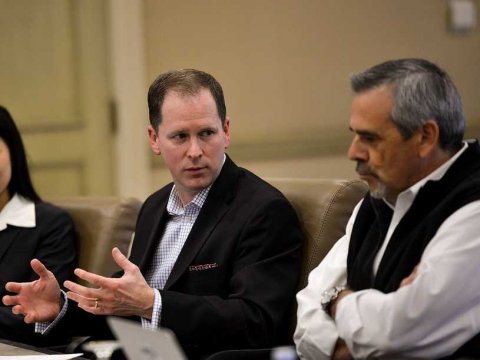The phrase “Must work well with others” is so commonly found on job descriptions for open positions that it gets ignored almost completely. And yet it’s not simply text placed there to fill space, nor is it an empty request–it’s a threat. If you don’t work well with others, you’re going to get fired. And not just from this job, but the next one as well, and the next, until you end up in a job where you don’t have to work well with others. And trust me, that’s not a job you want to have.
[fusion_builder_container hundred_percent=”yes” overflow=”visible”][fusion_builder_row][fusion_builder_column type=”1_1″ background_position=”left top” background_color=”” border_size=”” border_color=”” border_style=”solid” spacing=”yes” background_image=”” background_repeat=”no-repeat” padding=”” margin_top=”0px” margin_bottom=”0px” class=”” id=”” animation_type=”” animation_speed=”0.3″ animation_direction=”left” hide_on_mobile=”no” center_content=”no” min_height=”none”]

On the other hand, developing the right habits when it comes to working with others will result in leadership opportunities, higher pay, and more rewarding work. Based on my experience running a business for the past 15 years, I’ve listed 30 habits below which, when implemented correctly, I’ve seen contribute to individual and team success.
Some of the practices may seem obvious, but if they were obvious to everyone, everyone would get them right. Chances are for every habit I’ve listed below you know someone who gets it wrong. There are a lot more ways to work well with others, but I chose to mention the practices I feel provide the largest benefits with the least amount of effort. Many of them don’t require much more than remembering to do them. But I recognize even that can be difficult. The trick is to practice a few of them consistently for 3 to 4 weeks until they become habits, and then move on to the next group.
Many of these items might seem like small things, but getting just a few wrong–or right–can be the difference between keeping a job and getting fired, getting a promotion or staying where you’re at, progressing at work or standing still, and developing rewarding relationships at work or feeling like a loser. Let’s start with personal hygiene.
1. Brush your teeth. Or do whatever it takes to get rid of your bad breath. I once had a member of my team who had horrible breath. It was noticeable every time I spoke with him. I was hesitant to let him talk to clients. I finally mustered up the courage to talk with him about it and learned that he had a physical condition that caused the bad breath, and the only cure was surgery. Most of us don’t have such a barrier to making our breath a non-issue. Brush, use mouthwash, chew gum–just make sure you aren’t causing paint to peel off the walls whenever you exhale.
Like this Article ?? Share it ! First Sun Consulting, LLC- Outplacement/Executive Coaching Services, is Proud to sponsor/provide our ‘FSC Career Blog’ Article Below. Over 600 current articles like these are on our website in our FSC Career Blog (https://www.firstsun.com/fsc-career-blog/) with the most updated/current articles on the web for new management trends, employment updates along with career branding techniques .
You now can easily enjoy/follow Today our Award Winning Articles/Blogs with over 120K participates Worldwide in our various Social Media formats below:
- FSC LinkedIn Network: Over 6K+ Members & Growing ! (76% Executive Level of VP & up), Voted #1 Most Viewed Articles/Blogs, Members/Participants Worldwide (Members in Every Continent Worldwide) : Visit us @: @ http://www.linkedin.com/in/frankfsc , Look forward to your participation.
- Twitter: Follow us @ firstsunllc
educate/collaborate/network
Look forward to your Participation !
continue of article:
2. Use deodorant. Bad breath is bad enough, but don’t layer it on with body odor as well. You might think this is obvious and doesn’t need to be included in this list, but I’ll bet you know someone who is fragrantly challenged. You want them to get it together, but you’re not sure how to approach them. Now’s your chance. Share this list with them, ostensibly because of something else on it, as in “We really need to work harder on #15 around here…,” and hope they pick up on this tip as well. You’re welcome.
3. Don’t swear. In his book The Hard Thing About Hard Things, Ben Horowitz talks about how he confronted complaints about pirate language in the workplace. The solution he came to was not to ban cursing in the workplace, but make sure it didn’t devolve into sexual harassment or verbal abuse. I wouldn’t ban it either, even though I don’t swear and prefer a workplace where no one else does either. But as a member of a team it’s as simple as this–if you swear you will probably offend someone, and if you don’t, you will offend no one. Not swearing is an easy way to minimize the risk of pushing co-workers away.
4. Respond to emails immediately. Productivity guru David Allen, author of the classic Getting Things Done: The Art of Stress-Free Productivity, has a two-minute rule. If it will take less than two minutes to respond to an email, respond immediately. If it will take longer, mark it for follow up. I would add that even when it will take longer to compose a full response, you should compose a short response, even if it’s no more than “Just wanted to let you know I got this, I’ll respond in more detail by end of day today.”
5. Respond to emails–always. Ever notice how on sitcoms nobody says “bye” at the end of phone calls? Don’t make the same mistake with email correspondence. Many people ask a question via email, get a response, and then never respond with “Thanks!” An email dialogue is active until it’s closed, and you don’t want to be the one to leave it open. Don’t leave those you communicate with wondering if you received what they sent you.
6. Double check your email responses. Take 10 seconds before sending any email to check two things; 1) that you’re sending it to the right person, 2) that you remembered any attachments. I once had a team member who violated this rule (along with #3 above) when he sent an email to another member of our team saying “How about that guy we met with yesterday? What an ___hole!” The problem is he accidentally sent it straight to the guy he was talking about. We lost a strategic partner over that. A few seconds can prevent this kind of tragedy.
7. Don’t make noise. Your Spotify playlist is awesome, but keep it to yourself. Wear headphones, keep them low enough that they’re not just low-volume speakers, and do everything else you can to minimize making distracting or annoying noises that might interrupt your fellow team members.
8. Stay positive. Being happy isn’t dictated by what happens to you, it’s a choice. In the book Man’s Search For Meaning, psychologist and Nazi concentration camp survivor Viktor Frankyl detailed how even when everything terrible that can possibly be done to a human being had been done to him, he realized he still had the freedom to choose his response to it. Successful people are positive, and successful people help each other become more successful. If that’s the crowd you want to run with, always look on the bright side and be solution oriented, especially when it’s hard.
9. Be honest, but tactful. There are 100 wrong ways to say the right thing. Remember my team member with the bad breath? I could have told him “Your breath smells like something dark and evil crawled into your throat and died. What’s your problem?” Technically, I would have been correct on the facts, but my goal was to solve the problem without causing a host of others. I was direct, but showed respect and concern without judging him.
10. Smile. People like people who smile. People who smile are happier and more successful. And there’s a science behind it, as Buffer’s Leo Widrich points out in his excellent blog post The Science of Smiling: A Guide to Human’s Most Powerful Gesture. Smiling is also quite affordable.
11. Remember names. It might be one of the most valuable tidbits of wisdom in Dale Carnegie’s classic How to Win Friends and Influence People. Carnegie sums it up:
If you want to win friends, make it a point to remember them. If you remember my name, you pay me a subtle compliment you indicate that I have made an impression on you. Remember my name and you add to my feeling of importance.
12. Know the “love languages.” Everyone has “love languages” through which they express and interpret affection and appreciation. Gary Chapman pioneered this concept in his bestselling book The 5 Love Languages: The Secret to Love that Lasts, but the book you want to read is its companion The 5 Languages of Appreciation in the Workplace: Empowering Organizations by Encouraging People. Applying what you learn in this book will ensure that if you work with someone whose language of appreciation is gifts, you won’t be focusing your time on praising them instead.
13. Pick up small pieces of trash. If your immediate thought is “Isn’t that somebody else’s job?” then you’re not the kind of person I want on my team. The people I want to lead within my company are the ones who pitch in wherever they can. Instead of asking “Can’t someone else do it?” they’re asking “Is this a systemic issue or a one-time problem?” Either way, they fix the immediate issue rather than walking on by.
14. Look at people when they’re talking. We look away from others’ faces when we lack confidence, are lying, or just have poor habits. If you’re lying, stop it (tip #31), but most of us are just uncomfortable staring at someone’s face. There’s only one way to get over it and make it feel natural, and that’s to practice doing it until it become a habit. Looking away once in a while for a second is still natural–there’s no need for a rock-steady gaze, but if you find yourself saying entire sentences while staring away from the person you’re speaking to then there’s room for improvement.
15. Plan your day. There are many ways to plan out your day, but to make it simple, carve out 10 minutes each morning to run through your day, make a list of what you want to get done, and schedule when you’ll do it. At the end of the day, review your plan. Don’t let your inbox manage your time. People enjoy working with other people who are in control, and they lose respect for those who are constantly scrambling about putting out fires.
16. Take responsibility. When something goes wrong, it’s human nature to say “It wasn’t my fault.” What you’re also saying is “I wasn’t in control of the situation.” That isn’t exactly reassuring to those who depend on you. People feel safe around others who are in control and have the power to bend reality to their wills. Take responsibility, plan for success, and you’ll find yourself surrounded by people who want to help you succeed.
17. Say “no.” I’ve worked with people who agreed to any request I made, but then only delivered half the time. I can’t work with that type of person, because they make me look bad. I’d much rather they say “Sorry, I’m too busy to take that on this week.” Know your limits, set boundaries, and have the courage to stick to them.
18. Default to “yes.” Not to be confused as contradictory with #17, while knowing when to say “no” is critical, always follow Guy Kawasaki’s advice to default to “yes.” This doesn’t mean agreeing to do anything anyone asks of you, but it does mean giving every request serious consideration.
19. Get healthy. Some challenges are outside our control, but many health issues are caused by a lack of exercise and an unhealthful diet. Where possible, get in a habit of daily exercise and healthful eating. If you’re unavailable to work with others due to health challenges nobody might blame you, but you’re still missing out on opportunities. I know from firsthand experience how hard it can be to make the necessary lifestyle changes, having been the most unhealthy member of my team for several years. In 2007 I took drastic measures and got into triathlons, trail running, and started researching health and nutrition. Right now I’m enjoying reading Eat to Live by Joel Fuhrman, but there are lots of good books out there and free websites like No Meat Athlete and Green Smoothie Girl. My improved health has had a direct effect on the success of my business and my relationships with my team.
20. Put your phone away. If your phone is on the table while you’re speaking to someone, the message you are sending is “I’m waiting for something more important than you.” If you’re holding your phone in your hand, the message is “You’re not nearly as important as what you’re keeping me from doing on my phone.”
21. Hang out. Your co-workers don’t have to be your best friends or family, but there is something to be said for spending casual time with co-workers once in a while. You’ll learn things about them you would never learn at work, and you’ll create positive bonds that can aid in your work relationships.
22. Assume the best. Have you ever made a negative assumption about someone based on something he did or said, only to find out later that your assumption was completely wrong? I seem to do this at least once a week. I’ve found it handy as a mental exercise to try and make up my own excuses for the person in question. Give others the benefit of the doubt when there’s a question, and then work to verify the facts.
23. Don’t interrupt. Sometimes we just can’t wait to get our brilliant ideas out. Stop. Relax. People aren’t impressed when you talk, they’re impressed when you listen. If you want people to love you, get them talking about themselves, and then don’t do anything to get in their way.
24. Share credit. Three things happen when you share credit for a job well done. First, the person you share credit with will like you. Second, everyone else will respect and like you, and they’ll want to work with you, because they’ll see that you don’t try to take all the glory for yourself. Third, you won’t look like a selfish jerk, which is what happens when you try to take credit for yourself, even if the credit is truly yours.
25. Think win-win. A zero-sum game is a situation where someone else’s gain is your loss, and vice versa. Some people see almost every situation in life this way. Is that the kind of person you want to work with? If you’re that way, will anyone want to work with you? Instead, look for the opportunities where everyone benefits and your career will move a lot faster. For more on win-win, there’s no better read than Stephen R. Covey’s masterpiece The 7 Habit of Highly Effective People.
26. Check your body language. In her book The Charisma Myth: How Anyone Can Master the Art and Science of Personal Magnetism, Olivia Fox Cabane shows how your body language can turn people off, or make them comfortable around you. This body language can be learned, and those we think of as naturally charismatic are likely that way either because they worked on it, or grew up around people who had already had charismatic behaviors which they naturally adopted.
27. Keep an open mind. You might be 100% sure you’re right about something, and that your co-worker is wrong, but in any disagreement allow for the remote possibility that the case might be the opposite. Even if you’re right, when you’re sure you are you come across as a know-it-all, others will get defensive, and you won’t get the support you want. As the saying goes, a man convinced against his will is of the same opinion still. A little humility shows you’re more concerned about finding out what’s right than being right, and that makes people feel safe sharing their thoughts with you and working toward agreement.
28. Be on time. When you’re late for an appointment, you break your word and show that you’re unreliable. You’re also sending the message that the other person’s time doesn’t matter to you. That said, despite the best of intentions and preparations, sometimes things happen that are outside our control. When they do, communicate and renegotiate the time, apologize profusely, and if you’re ever late to anything ever again, make it isn’t a meeting with the same person.
29. Show sincere appreciation. When someone does a favor for you, thank them. When they do a good job on something, recognize it. It costs you nothing, but everyone walks away richer. If you have trouble feeling sincere at first, remember that if you sincerely want to be sincere, you are.
30. Don’t quit. I don’t mean you shouldn’t quit your job–maybe you should. I mean don’t give up on improving yourself. If you find yourself thinking “I’m just not very social, I’m just not good with people,” then you might be right, but the lie comes when you tell yourself you can’t change. You can’t change the cards you’ve been dealt, but you can do the best you can with what you’ve got, and you have substantially more opportunities to create a winning hand than in a game of poker. Many of the successful people around you aren’t that bright, they just kept on going when others quit. People like working with individuals who keep on going, no matter what.
What are the simple habits you’ve found that help you work well with others? Share in the comments below.
Joshua Steimle is the CEO of MWI, a digital marketing agency with offices in the U.S. and Hong Kong.
Forbes.com | January 18, 2015 | Joshua Steimle
[/fusion_builder_column][/fusion_builder_row][/fusion_builder_container]













